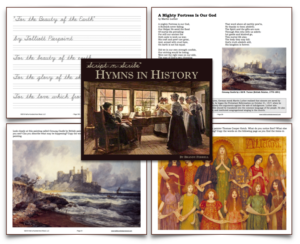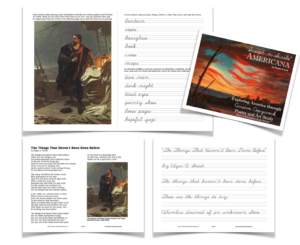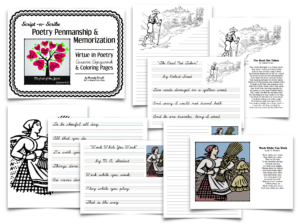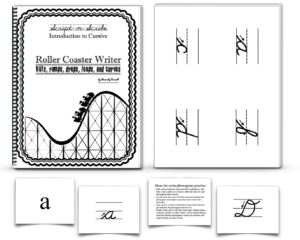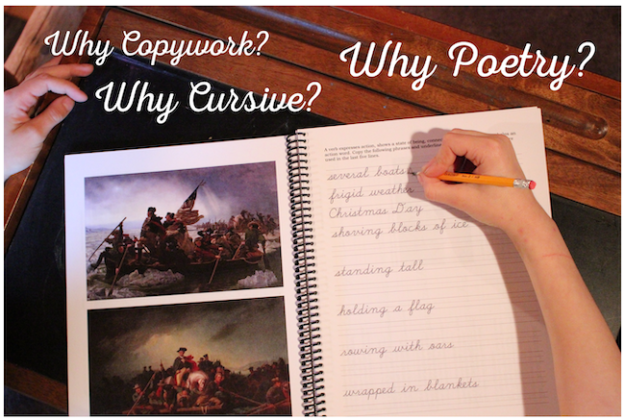
During my first years of homeschooling, many questions plagued me, especially as we found ourselves in the midst of a community of classical educators…
Why introduce my children to cursive handwriting?
Why emphasize the mundane act of copywork?
Why read poetry, much less memorize it?
Although I liked the idea of a classical education for other reasons, these things seemed unnecessary… and a bit boring.
My previous attitude may have stemmed from my natural affinity towards math and science and my general dislike of linguistic and literary studies. But over time I’ve come to appreciate these important elements of our homeschool. Here’s a brief Cliffs-notes-style synopsis of what I’ve realized as we’ve hiked along our homeschool journey (although I’ve read many other, more convincing arguments regarding each of the following).
Why introduce my children to cursive handwriting?
- Cursive is personal. I have kept the letters my mom and sisters wrote to me 15-20 years ago. These treasures are so precious to me, as they are all written in the unique cursive handwriting of my loved ones. Their handwriting is an expression of who they are, just as my own sloppy, scatterbrained cursive-print mix is an expression of who I am. There is nothing more special to me than to receive a handwritten note (which also includes a special signature unique to that person).
- Not only are many historical documents written in cursive, so are many of the letters and journal entries of our ancestors. Perhaps we can learn to read cursive without learning to write cursive, but I don’t want to take a chance of my children losing the ability to connect with these important historical documents and beloved family keepsakes.
- My memory and prayer journals are written in cursive. Although some (like my husband) may argue that my handwriting is practically illegible anyway, I want my children to be able to read what I have written.
- Cursive is beautiful. It’s a form of artwork. We don’t eliminate things like artwork from our learning experience simply because it’s not necessary. Pausing to concentrate on good penmanship slows us down in this fast-paced world. In that pause lies much beauty that we would fail to behold otherwise. Sometimes we create beautiful things just for the sake of beauty.
- If cursive is taught before print handwriting, it makes the process of handwriting much easier. Read our story here.
Why emphasize the mundane act of copywork?
The act of copying a piece of well-written work onto paper emphasizes proper spacing, capitalization, and punctuation and provides a springboard for English grammar instruction. When used consistently, it is a method that will improve a child’s penmanship, grammar, and punctuation skills. Moreover, it exposes a child to a variety of literary structures and styles as he/she imitates the finest works of the finest authors and poets. Though a simple skill, copywork can greatly enhance a child’s ability to write well later in life, for it provides exposure to the ideas and techniques of the great masters of literature.
By simply copying words onto paper, our oldest son (age 11) memorized and later performed the last lines of Patrick Henry’s “Give Me Liberty or Give Me Death” speech at an American Revolution festival near our home. I did not plan for him to memorize it, nor did he; it just happened. We didn’t even realize that he had it memorized until I started reading the words to our other children, and he started quoting it along with me. Copywork can be such a wonderful tool for memorization!
Why read poetry, much less memorize it?
The rhythmic lines and descriptive imagery within a poem express deep emotion and engage our imaginations. Reading and memorizing poetry improves vocabulary and provides students with a storage bank of descriptive words while giving a student language patterns, ideas, and imagery to use within his own speaking or writing. Reciting poetry provides an opportunity to focus on presentation, fluency, and expression.Every autumn and spring as I behold the beauty of the changing seasons, I remember the lines of Robert Frost’s “Nothing Gold Can Stay.” It’s a beautiful reminder to enjoy the moment, that things change and that the only things in life that remain are those of eternal value – a reminder that can be quoted without seeming to my children like a sermon or lecture. (In fact, I quote parts of this poem to my children in our normal, everyday lives.) Memorizing poetry makes it a part of my self, which gives me lovely words and thoughts to ponder in the midst of sorrow or joy, in the midst of any circumstance I might face. Poetry simply touches the heart of man. Why not share this gift of beauty with our children?
A resource that combines cursive, copywork, picture study, and poetry
The Script-n-Scribe Cursive Program was developed to seamlessly integrate picture study and poetry into the school day. Script-n-Scribe provides a full cursive program – from the formation of individual letters, through practicing tricky letter combinations, to seamlessly and effortlessly encouraging the study of art and poetry while gently introducing and reviewing English grammar concepts. Read more by clicking on the individual options below.


